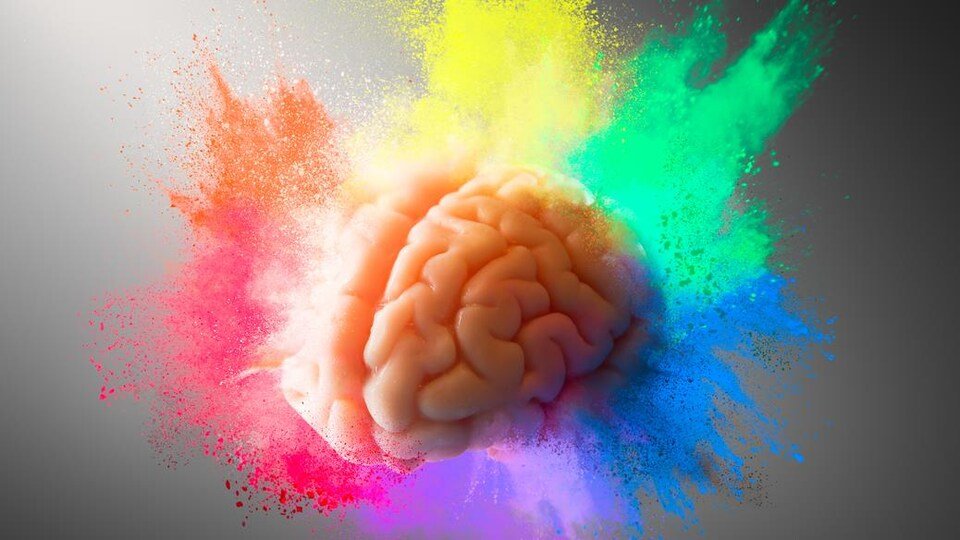Drug-induced synesthesia and genuine synesthesia – a comparable phenomenon?
Synesthesia is usually defined as a coupling of sensory perceptions in which the perception of one stimulus leads to an internally generated perception of another stimulus. Synesthetic experiences have been reported to be a common effect of psychedelics and occur even at low doses (1).
However, most of the scientific literature is based on genuine synesthesia, which is characterized by being present since birth or early childhood. There is only little literature addressing drug-induced synesthesia.
How does synesthesia emerge in the brain?
Synesthesia is thought to be the result of some form of ‘hyper-association’ in the brain (2). However, the underlying neurophysiological processes are still unclear. Various models exist that attempt to explain the emergence of a synesthetic experience in the brain, but so far none of the hypotheses have generated conclusive evidence. And that’s where the psychedelic induced synesthetic experiences come into play. The fact that psychedelics can induce synesthetic experiences in a non-synesthetic individual is sometimes used to explore the underlying neurophysiological mechanisms of genuine synesthesia(3). The main argument is that the possibility of drug-induced synesthesia shows that synesthesia is based on normally existing networks in the brain rather than on abnormal connections that occur only in individuals with synesthesia. A synesthetic experience occurring shortly after ingestion of the psychedelic substances leaves too little time for the brain to build new neural connections (4). This suggests that genuine synesthesia is not due to structural differences in the brain.
Makes sense, no? But is this sufficient to draw conclusions from the drug-induced synesthesia to the underlying mechanism of genuine synesthesia? Let’s take a closer look.
Consistency
In genuine synesthesia a particular inducer always triggers a particular accompanying sensation, the so-called concurrent (5). For example, the letter B is always perceived with the accompanying sensation of a blue color. The coupling of the trigger with a specific concurrent show even a high consistency over decades.(6)
Drug-induced synesthesia, on the other hand, shows a high inconsistency with respect to the coupling of trigger and concurrent. A certain trigger can lead to a sensation at one moment and at another moment the same stimulus can lead to a different or even to no sensation (7).
Features of the inducer
Genuine and drug-induced synesthesia also differ in the properties of the triggering stimuli, the so-called inducer.
Typical inducers of drug-induced synesthesia are sensory stimuli like sounds, music, smells, or even touch. Auditory stimuli seem to be the most common inducer of drug-induced synesthesia (8). They are mostly accompanied by visual sensations (9).
Whereas in most cases of genuine synesthesia, the inducer is a number, letter, month, or day of the week(10). It is interesting that the most common inducers of genuine synesthesia are representing a concept. Researchers have suggested that it is not the shape of a letter that triggers the sensation of a color in grapheme-color synesthesia, but its interpretation, classification, and context(11) . This finding suggests that cognitive interpretations play a major role in genuine synesthesia.
However, conceptualization seems to play a rather small role in drug-induced synesthesia, since in most cases the inducers are sensory stimuli that do not require higher conceptualization.
Are drug-induced synesthesia and genuine synesthesia a comparable phenomenon?
I argue that they are not comparable. As we have seen, drug-induced synesthesia and genuine synesthesia differ highly in terms of consistency and features of the inducer. It is apparent that the two phenomena, which are very different in their phenomenology, are possibly based on different neurophysiological processes and they are therefore too different to serve as an experimental version of the other. That’s why I think that one should be cautious in drawing conclusions about the underlying mechanisms of genuine synesthesia based on evidence from drug-induced synesthesia. Hopefully, future research will tell us more about the common or different underlying mechanism of drug-induced or genuine synesthesia.
References:
Preller, K. H., & Vollenweider, F. X. (2016). Phenomenology, Structure, and Dynamic of Psychedelic States. Behavioral Neurobiology of Psychedelic Drugs, 221–256. https://doi.org/10.1007/7854_2016_459
Simner, J. (2011). Defining synaesthesia. British Journal of Psychology, 103(1), 1–15. https://doi.org/10.1348/000712610x528305
Grossenbacher, P. G., & Lovelace, C. T. (2001). Mechanisms of synesthesia: cognitive and physiological constraints. Trends in Cognitive Sciences, 5(1), 36–41. https://doi.org/10.1016/s1364-6613(00)01571-0
Nair, A., & Brang, D. (2019). Inducing synesthesia in non-synesthetes: Short-term visual deprivation facilitates auditory-evoked visual percepts. Consciousness and Cognition, 70, 70–79. https://doi.org/10.1016/j.concog.2019.02.006
Brogaard, B. (2013). Serotonergic Hyperactivity as a Potential Factor in Developmental, Acquired and Drug-Induced Synesthesia. Frontiers in Human Neuroscience, 7.
Simner, J., & Logie, R. H. (2008). Synaesthetic Consistency Spans Decades in a Lexical–Gustatory Synaesthete. Neurocase, 13(5–6), 358–365. https://doi.org/10.1080/13554790701851502
Sinke, C., Halpern, J. H., Zedler,M., Neufeld, J., Emrich, H. M., & Passie, T. (2012). Genuine and drug-induced synesthesia: A comparison. Consciousness and Cognition, 21(3), 1419–1434. https://doi.org/10.1016/j.concog.2012.03.009
Luke, D. P., Lungu, L., Friday, R., & Terhune, D. B. (2022). The chemical induction of synaesthesia. Human Psychopharmacology: Clinical and Experimental, 37(4). https://doi.org/10.1002/hup.2832
Sinke, C., Halpern, J. H., Zedler,M., Neufeld, J., Emrich, H. M., & Passie, T. (2012). Genuine and drug-induced synesthesia: A comparison. Consciousness and Cognition, 21(3), 1419–1434. https://doi.org/10.1016/j.concog.2012.03.009
Sinke, C., Halpern, J. H., Zedler,M., Neufeld, J., Emrich, H. M., & Passie, T. (2012). Genuine and drug-induced synesthesia: A comparison. Consciousness and Cognition, 21(3), 1419–1434. https://doi.org/10.1016/j.concog.2012.03.009
Sinke, C., Halpern, J. H., Zedler,M., Neufeld, J., Emrich, H. M., & Passie, T. (2012). Genuine and drug-induced synesthesia: A comparison. Consciousness and Cognition, 21(3), 1419–1434. https://doi.org/10.1016/j.concog.2012.03.009




